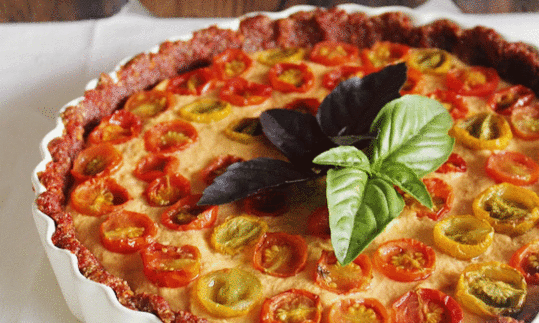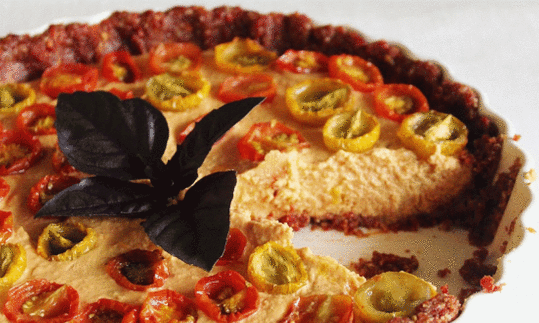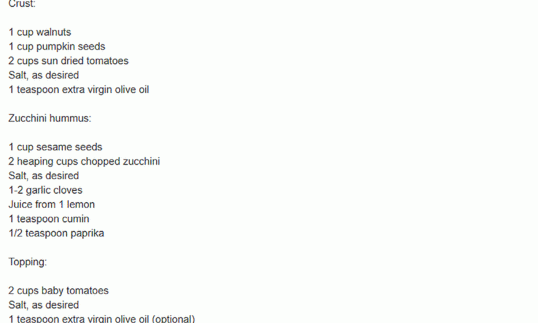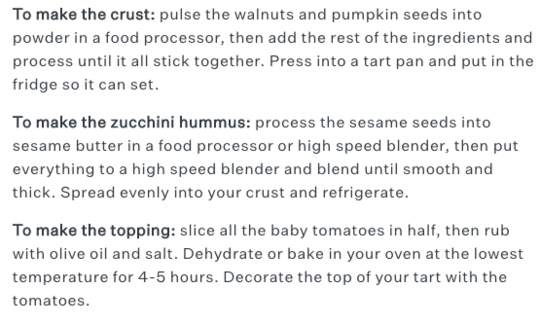Sun-Dried Tomato Tart with Zucchini Hummus
raw-vegan
Ingredients (for servings, )
| For the crust | |
|---|---|
| 3 ½ oz | Walnuts (tree nuts), raw (organic?) |
| 1 cup | Pumpkin seeds, dried, raw (organic?) (4.5 oz) |
| 2 cups | Tomatoes, dried (raw?, organic?) (8.4 oz) |
| 1 dash | Table salt (table salt, raw?, organic?) (0.01 oz) |
| 1 tsp | Olive oil (cold pressed, raw?, organic?) (0.16 oz) |
| For the zucchini hummus | |
| 1 cup | Sesame, raw, unpeeled (sesame seeds, organic?) (5.1 oz) |
| 1 | Lemons, raw (limes, organic?) (2.0 oz) |
| 2 cup, chopped | Zucchini, raw, (organic?) (8.7 oz) |
| 1 dash | Table salt (table salt, raw?, organic?) (0.01 oz) |
| 2 cloves | Garlic (organic?) (0.21 oz) |
| 1 tsp | Cumin, ground (raw, organic?) (0.11 oz) |
| ½ tsp | Paprika powder, hot (raw?, organic?) (0.04 oz) |
| For the topping | |
| 2 cups | Cherry tomatoes, raw (cherry tomatoes, organic?) (10 oz) |
| 1 dash | Table salt (table salt, raw?, organic?) (0.01 oz) |
| 1 tsp | Olive oil (cold pressed, raw?, organic?) (0.16 oz) |
Equipment
- blender or hand-held blender / immersion blender
- dehydrator or oven
- food processor
- baking pan (springform pan)
- refrigerator
- citrus juicer (lemon squeezer)
Type of preparation
- dehydrate
- chop or grind
- food preparation without heating
- blend
- squeeze
- cool
Preparation
To make the crust
Pulse the walnuts and pumpkin seeds into powder in a food processor. Then add the rest of the ingredients and process until it all sticks together. Press into a tart pan and put in the fridge so it can set.The original recipe calls for 1 cup shelled walnuts (approx. 100 g) for 6 servings.
To make the zucchini hummus
Process the sesame seeds into sesame butter in a food processor or high speed blender. Then put everything in a high speed blender and blend until smooth and thick.
Spread evenly on your crust and refrigerate.To make the topping
Slice all the baby tomatoes in half, and then rub with olive oil (optional) and salt. Dehydrate or bake in your oven at the lowest temperature for 4–5 hours.Save time: You can make the topping before you make the crust and zucchini hummus. You can also reduce the amount of time that you dehydrate or bake the tomatoes to 2–3 hours. Test the tomatoes after this amount of time. If needed, dehydrate them a little longer.
Finishing the tart
Garnish the top of your tart with the tomatoes and serve.
|
Nutritional Information per person
Convert per 100g
|
2000 kcal | |
|---|---|---|
| Energy | 506 kcal | 25.3% |
| Fat/Lipids | 36 g | 52.0% |
| Saturated Fats | 5.0 g | 25.0% |
| Carbohydrates (inc.dietary fiber) | 37 g | 13.8% |
| Sugars | 18 g | 20.5% |
| Fiber | 12 g | 46.3% |
| Protein/Albumin | 20 g | 40.3% |
| Cooking Salt (Na:131.9 mg) | 335 mg | 14.0% |
| Essential micronutrients with the highest proportions | per person | 2000 kcal | |
|---|---|---|---|
| Min | Copper, Cu | 2.2 mg | 217.0% |
| Fat | Linoleic acid; LA; 18:2 omega-6 | 17 g | 166.0% |
| Min | Manganese, Mn | 3.0 mg | 152.0% |
| Prot | Tryptophan (Trp, W) | 0.30 g | 119.0% |
| Elem | Potassium, K | 1'987 mg | 99.0% |
| Elem | Phosphorus, P | 650 mg | 93.0% |
| Elem | Magnesium, Mg | 332 mg | 88.0% |
| Fat | Alpha-Linolenic acid; ALA; 18:3 omega-3 | 1.7 g | 84.0% |
| Min | Iron, Fe | 10 mg | 73.0% |
| Prot | Threonine (Thr, T, irreversibly transaminated) | 0.66 g | 71.0% |
Detailed Nutritional Information per Person for this Recipe
The majority of the nutritional information comes from the USDA (US Department of Agriculture). This means that the information for natural products is often incomplete or only given within broader categories, whereas in most cases products made from these have more complete information displayed.
If we take flaxseed, for example, the important essential amino acid ALA (omega-3) is only included in an overarching category whereas for flaxseed oil ALA is listed specifically. In time, we will be able to change this, but it will require a lot of work. An “i” appears behind ingredients that have been adjusted and an explanation appears when you hover over this symbol.
For Erb Muesli, the original calculations resulted in 48 % of the daily requirement of ALA — but with the correction, we see that the muesli actually covers >100 % of the necessary recommendation for the omega-3 fatty acid ALA. Our goal is to eventually be able to compare the nutritional value of our recipes with those that are used in conventional western lifestyles.
| Essential fatty acids | per person | 2000 kcal |
|---|---|---|
| Linoleic acid; LA; 18:2 omega-6 | 17 g | 166.0% |
| Alpha-Linolenic acid; ALA; 18:3 omega-3 | 1.7 g | 84.0% |
| Essential amino acids | per person | 2000 kcal |
|---|---|---|
| Tryptophan (Trp, W) | 0.30 g | 119.0% |
| Threonine (Thr, T, irreversibly transaminated) | 0.66 g | 71.0% |
| Isoleucine (Ile, I) | 0.73 g | 59.0% |
| Phenylalanine (Phe, F) | 0.90 g | 58.0% |
| Valin (Val, V) | 0.88 g | 55.0% |
| Leucine (Leu, L) | 1.3 g | 54.0% |
| Methionine (Met, M) | 0.37 g | 40.0% |
| Lysine (Lys, K, irreversibly transaminated) | 0.73 g | 39.0% |
| Vitamins | per person | 2000 kcal |
|---|---|---|
| Vitamin B1 (Thiamine) | 0.56 mg | 51.0% |
| Vitamin B9, B11 (Folate, as the active form of folic acid) | 98 µg | 49.0% |
| Vitamin C (ascorbic acid) | 36 mg | 45.0% |
| Vitamin B3 (Niacin) | 6.5 mg | 41.0% |
| Vitamin B6 (pyridoxine) | 0.58 mg | 41.0% |
| Vitamin K | 26 µg | 35.0% |
| Vitamin B7 (Biotin, ex vitamin H) | 17 µg | 33.0% |
| Vitamin B2 (Riboflavin) | 0.37 mg | 26.0% |
| Vitamin B5 (Pantothenic acid) | 1.3 mg | 21.0% |
| Vitamin E, as a-TEs | 1.3 mg | 11.0% |
| Vitamin A, as RAE | 48 µg | 6.0% |
| Essential macroelements (macronutrients) | per person | 2000 kcal |
|---|---|---|
| Potassium, K | 1'987 mg | 99.0% |
| Phosphorus, P | 650 mg | 93.0% |
| Magnesium, Mg | 332 mg | 88.0% |
| Calcium, Ca | 325 mg | 41.0% |
| Sodium, Na | 132 mg | 16.0% |
| Essential trace elements (micronutrients) | per person | 2000 kcal |
|---|---|---|
| Copper, Cu | 2.2 mg | 217.0% |
| Manganese, Mn | 3.0 mg | 152.0% |
| Iron, Fe | 10 mg | 73.0% |
| Zinc, Zn | 5.1 mg | 51.0% |
| Selenium, Se | 14 µg | 25.0% |
| Iod, I (Jod, J) | 5.3 µg | 4.0% |
| Fluorine, F | 1.6 µg | < 0.1% |
This Sun-Dried Tomato Tart with Zucchini Hummus has a crust made from walnuts and sun-dried tomatoes and is a fresh, raw vegan version of a traditional quiche.
Servings: The author did not specify a serving size. Since the recipe makes a tart that fits in a large quiche pan, we have set it for 6 servings.
Preparation time: The author did not specify the preparation time, so we have estimated it. We have assumed that you begin with step 3 and dehydrate the tomatoes for a maximum of 2.5 hours.
Nutritional profile: According to GDA guidelines, one serving exceeds the recommended daily requirement of the trace elements copper and manganese, which are important for the formation of cartilage tissue. It also covers the recommended daily requirement for potassium and the essential amino acid tryptophan. The ratio of omega-6 to omega-3 fatty acids in the tart is 10:1, which unfortunately significantly exceeds the recommended maximum ratio of 5:1. For this reason, we have created a health-optimized version of the recipe. You can find the link to the recipe and information on the reason behind our choice above the recipe photo.
Walnuts: Walnuts are the nuts that contain the highest proportion of linolenic acid (an omega-3 fatty acid that is healthy for the heart). In addition, they are rich in vitamin E, zinc (an important trace element for the liver and hair), and potassium (essential for the functioning of the heart and other organs).
Pumpkin seeds: Dried pumpkin seeds are rich in nutrients (e.g., protein, dietary fiber, iron, zinc, and magnesium). However, at 172:1, their ratio of omega-6 to omega-3 fatty acids by far exceeds the recommended maximum ratio of 5:1.
Sesame seeds: Sesame (Sesamum indicum) is an annual flowering plant that originated in certain areas of India and Africa. Today, it is widely cultivated in tropical and subtropical regions around the world and is valued for its oil and edible seeds. Sesame seed is one of the oldest oilseed crops known, and archeologists have documented evidence that the wild variety was domesticated in Asia around 3'000 BC. Sesame oil, sesame seeds, and the root have therapeutic and culinary uses. Depending on the type, the seed pods contain either black, brown, or white seeds. Black sesame seeds (Sesamum indicum nigrum) are more aromatic than the white variety. Sesame contains high amounts of calcium and selenium. However, it is also a strong allergen, which is why sesame must be declared on labels.
Sun-dried tomatoes: The drying process removes moisture from the tomatoes and blocks the “growing” of microorganisms. This allows the tomatoes to be stored for a longer period of time. The drying process also increases the concentration of aromatic substances, which is why dried tomatoes have a very intense flavor.
Side dish or entrée: This sun-dried tomato tart can be eaten as an entrée or a side dish. A side salad also goes well with this dish.
Zucchini: Zucchini shouldn’t be stored near apples, tomatoes, or other climacteric fruits. These fruits emit ethylene during the ripening process, which causes the zucchini to quickly ripen and spoil. You should not eat zucchini that taste bitter as this can be an indication of toxic bitter substances that can attack the gastrointestinal mucosa. When growing your own zucchini, you should make sure to neither cross-pollinate them using your own seeds nor to cross zucchini with other squash as this can result in a higher content of toxic bitter substances.
Healthy options: We have created a health-optimized recipe. To find out more, read this article: A Vegan Diet Can Be Unhealthy. Nutrition Mistakes.
Save time: You can make the topping before you make the crust and the zucchini hummus. You can also reduce the amount of time that you dehydrate or bake the tomatoes to 2–3 hours. Test the tomatoes after this amount of time. If needed, dehydrate them a little longer.









